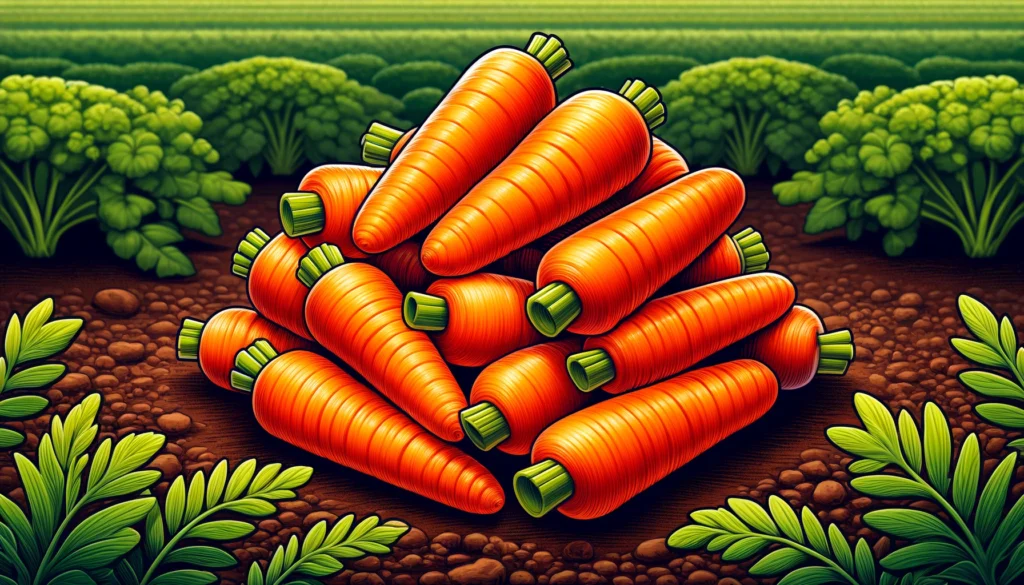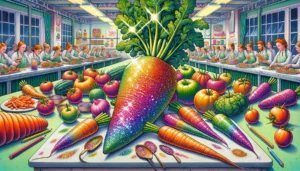
Carrots A vivid and detailed illustration of Baby carrots in a close up style. The Baby carrots are small cylindrical and uniform in size with a bright oran7.webp.webp
Baby Carrots: The Adorable Puppies of the Vegetable World
In the bustling world of vegetables, where size often seems to matter, a tiny and adorable contender is claiming its rightful place in the spotlight. Meet baby carrots, the snack-sized candies of the vegetable aisle that are bringing a burst of sweetness and joy to your culinary creations. These bite-sized vegetables are ready to prove that great things come in small packages.
The Rise of Baby Carrots
Baby carrots, often originating from larger varieties that are cut and shaped, are the epitome of convenience and cuteness. Known for their sweet flavor and crisp texture, baby carrots are the adorable puppies of the vegetable world, always ready to make you smile.
“Baby carrots are like the snack-sized candies of the carrot world,” says agricultural expert Dr. Root. “They’re tiny, sweet, and irresistibly cute.”
Despite their small stature, baby carrots have become a staple in lunchboxes and snack trays around the world. Their convenient size and delightful taste have made them a favorite among kids and adults alike, but their cuteness has kept them somewhat under the radar in the gourmet market.
The Culinary Potential of Baby Carrots
With their sweet flavor and crisp texture, baby carrots are a versatile ingredient that can be used in a variety of dishes. They can be roasted, boiled, steamed, or even eaten raw. Their small size and perfect shape make them a beautiful addition to salads, side dishes, and snacks.
“Baby carrots are a game-changer in the kitchen,” says Chef Snout. “Their sweet flavor and crisp texture make them a standout ingredient, and their adorable appearance adds a touch of joy to any dish.”
However, cooking with baby carrots is not without its challenges. Their small size requires careful handling to preserve their cute appearance. But for those who master the art of cooking with baby carrots, the rewards are well worth the effort.
Baby Carrots: A Joke?
-
- Why did the baby carrot use sunscreen?
Because it didn’t want to turn into a steamed carrot! - What do you call a baby carrot that’s a genius?
A “sharp” carrot! - Why was the baby carrot bad at poker?
You could always see its “roots”! - What did one baby carrot say to another during a race?
“I’m rooting for you!” - Why don’t baby carrots ever get lost?
Because they always find their “root” home! - How do baby carrots greet each other?
“Orange you glad to see me?” - Why did the baby carrot go to school?
To become a “full-grown” carrot! - What do you call a baby carrot that can sing?
A “carrot-tenor”! - What’s a baby carrot’s favorite game?
“Hide and Peek” — they’re always peeking out from under the soil! - Why did the baby carrot refuse to take a nap?
Because it wasn’t “peeled” yet!
- Why did the baby carrot use sunscreen?
Farmers Contemplating Growing Baby Carrots: A Guide
For farmers considering the plunge into growing baby carrots, be prepared for an adventure filled with cuteness and convenience. Here’s a guide to help you navigate the world of baby carrot farming.
1. The Adorable Garden: Baby carrots’ small, perfect shapes mean your farm will look like a field of vegetable puppies. Be prepared for curious visitors mistaking your fields for a petting zoo.
2. Cute Challenges: Baby carrots’ adorable nature might attract all sorts of critters. Consider installing tiny playgrounds to keep them entertained and away from your crop.
3. Sweet Appeal: Growing baby carrots will make you the talk of the town. Prepare for gourmet chefs knocking on your door, begging for a taste of your delightful tubers.
4. Culinary Challenges: Experiment with different cooking methods to find the perfect balance of flavor and texture. Don’t be afraid to get creative—baby carrots are all about adding a touch of joy to your dishes.
5. Limited Edition: Market your baby carrots as a limited-edition vegetable. Their rarity and unique flavor make them the perfect candidate for a culinary adventure.
Help for Farmers: Growing Baby Carrots
Growing baby carrots can be a rewarding venture for farmers, providing a delightful product that appeals to a wide range of consumers. Here are some practical tips and expert insights to help you succeed:
Step-by-Step Guide: Start with high-quality seeds or large carrots suitable for cutting into baby sizes. Ensure your soil is well-drained and rich in organic matter to promote healthy growth.
Pro Tips: Baby carrots require consistent moisture to develop their sweet flavor and crisp texture. Mulching can help retain soil moisture and keep the roots cool.
Insider Knowledge: Harvest baby carrots when they reach about 3-4 inches in length for the best flavor and texture. Larger carrots can be trimmed and shaped to create uniform baby carrots.
Expert Insights: Rotate your crops to prevent soil-borne diseases and pests. Baby carrots can be susceptible to root-knot nematodes, so consider planting them in a different location each year.
Best Practices: Use row covers to protect your baby carrots from pests and extreme weather conditions. Thin seedlings to ensure adequate space for each carrot to grow.
How-to Tutorials: Create videos or written guides on the process of planting, growing, and harvesting baby carrots. Share these resources with your customers to build trust and engagement.
Practical Advice: Market your baby carrots as a convenient and healthy snack option. Highlight their sweet flavor and nutritional benefits to attract health-conscious consumers.
Comprehensive Coverage: Provide detailed information on the benefits of baby carrots, including their high vitamin A content and low calorie count.
Resourceful Content: Offer recipes and serving suggestions to inspire your customers to use baby carrots in new and exciting ways.
Solutions-Oriented Approach: Address common challenges in growing baby carrots, such as pest control and soil management, with practical solutions.
Problem-Solving Strategies: Share tips on how to handle common issues like uneven growth or poor germination rates.
Actionable Recommendations: Recommend specific fertilizers or soil amendments that can improve the growth and flavor of baby carrots.
User-Friendly Explanations: Use simple, easy-to-understand language to explain the growing process to new farmers.
Clear Instructions: Provide step-by-step instructions for every stage of growing baby carrots, from planting to harvesting.
Data-Driven Analysis: Share statistics and research findings on the best growing practices for baby carrots.
Evidence-Based Strategies: Base your recommendations on proven methods and scientific research to ensure the best results.
Real-World Examples: Include case studies and success stories from other farmers who have successfully grown baby carrots.
Case Studies: Highlight specific examples of farms that have achieved success with baby carrots, detailing their methods and results.
Success Stories: Share testimonials from customers who love your baby carrots, emphasizing their sweet flavor and convenience.
Frequently Asked Questions (FAQs): Address common questions about growing and using baby carrots, such as the best time to plant and how to store them.
Troubleshooting Tips: Provide solutions for common problems, like pests or poor soil conditions, that can affect baby carrot growth.
Quick Fixes: Offer simple tips for improving the health and growth of baby carrots, such as adjusting watering schedules or using organic pest control.
Time-Saving Techniques: Share methods for streamlining the planting and harvesting process to save time and effort.
Cost-Effective Solutions: Recommend budget-friendly tools and supplies that can help farmers grow baby carrots without breaking the bank.
Money-Saving Hacks: Provide tips on how to reduce costs, such as using homemade compost or natural pest repellents.
Budget-Friendly Options: Suggest affordable alternatives to expensive fertilizers and soil amendments.
Insider Secrets: Share lesser-known tips and tricks from experienced farmers to help newcomers succeed.
Insider Tips: Provide advanced growing techniques that can give farmers an edge in producing high-quality baby carrots.
Insider Tricks: Reveal clever hacks for maximizing yield and flavor, such as optimal planting times and companion planting strategies.
Conclusion: Embracing the Adorable Puppies of the Vegetable World
In conclusion, baby carrots are not just a vegetable—they’re a culinary delight. From their sweet flavor to their crisp texture, baby carrots bring a burst of joy and convenience to any dish. As more people embrace these adorable tubers, the culinary landscape will be forever changed.
So the next time you come across baby carrots in a specialty market, don’t hesitate to give them a try. Let their unique appearance and flavor take you on a culinary adventure you won’t soon forget.
Disclaimer
This article is a human collaboration between a cowboy and a farmer. No tubers were harmed in the making of this article, although several did enjoy a bit of extra seasoning. Always consult a culinary expert before attempting to cook with rare vegetables. Remember, tubers are for eating, not just for admiring.
15 Educational Observations About Baby Carrots
- Baby carrots are like the snack-sized candies of the carrot world—tiny, sweet, and irresistibly cute.
- If baby carrots could talk, they’d probably giggle and ask for a hug.
- Baby carrots are the adorable puppies of the vegetable aisle, always ready to make you smile.
- Eating baby carrots is like munching on crunchy, bite-sized bursts of joy.
- Baby carrots are so cute, they probably get away with everything, even in the vegetable drawer.
- If baby carrots were party guests, they’d be the ones bringing mini hors d’oeuvres and tiny party hats.
- Baby carrots think they’re the darlings of the carrot family, and with that cuteness, who can argue?
- The only thing missing from baby carrots’ look is a tiny bow tie and a squeaky toy.
- Baby carrots’ idea of a perfect day is lounging in a lunchbox, waiting to be admired.
- If baby carrots were characters in a movie, they’d be the adorable sidekicks everyone loves.
- Baby carrots’ sweet flavor is their way of saying, “I’m not just small—I’m delightful.”
- If baby carrots had a fashion show, their tiny, perfect shapes would be all the rage on the runway.
- Baby carrots’ crisp taste makes them the life of any healthy snack party.
- The only thing baby carrots love more than being cute is being the star ingredient in a dish.
- If baby carrots had a fan club, it would be filled with kids, health nuts, and snack enthusiasts.
Comprehensive List of Carrot Varieties
Nantes, Imperator, Danvers, Chantenay, Baby carrots, Bolero, Touchon, Scarlet Nantes, Royal Chantenay, Autumn King, Red Core Chantenay, Cosmic Purple, Lunar White, Atomic Red, Purple Haze, Little Finger, Parisian, Yellowstone, Sugarsnax, Healthmaster, Mokum, Amsterdam, St. Valery, Kuroda, Nantes Half Long, Berlicum, Laguna, Romance, Napoli, Nelson
Originally posted 2006-05-12 04:18:33.
Originally Published at FarmerCowboy.com
2024-06-25 05:51:45
Originally posted 2024-06-26 07:51:08.
Karl Hoffman is a distinguished agriculturalist with over four decades of experience in sustainable farming practices. He holds a Ph.D. in Agronomy from Cornell University and has made significant contributions as a professor at Iowa State University. Hoffman’s groundbreaking research on integrated pest management and soil health has revolutionized modern agriculture. As a respected farm journalist, his column “Field Notes with Karl Hoffman” and his blog “The Modern Farmer” provide insightful, practical advice to a global audience. Hoffman’s work with the USDA and the United Nations FAO has enhanced food security worldwide. His awards include the USDA’s Distinguished Service Award and the World Food Prize, reflecting his profound impact on agriculture and sustainability.





